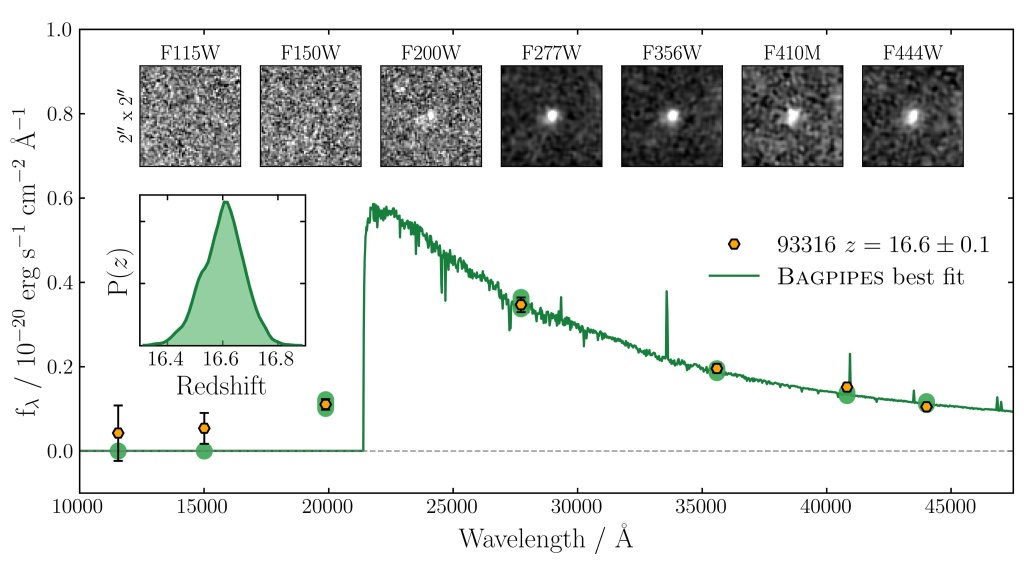Now a Galaxy at z>16?
It’s less than a week since I posted an item about an object which is possibly the highest redshift galaxy ever observed (with z ~13) and now along comes a paper describing an object that may be of even higher redshift (with z~16.7). The abstract of the new paper – lead author of which is Callum Donnan of the University of Edinburgh – is here:
As with the previous object the redshift of this one is not obtained via spectroscopy (which usually involves the identification of spectral lines) but via fitting a spectral profile to photometric imaging data seen in different bands. The process for this galaxy is illustrated by this diagram from the paper:

There are 7 images along the top showing the source through various broad band filters. Suitably calibrated these can be converted to the flux measurements shown on the graph. Notice the first three images are significantly fainter than the others, so the first three points on the left of the graph are lower.
If this is a galaxy its spectrum is expected to possess a Lyman Break resulting from the fact that radiation of shorter wavelength than the Lyman Limit (912 Å) is absorbed by neutral gas surrounding the regions where stars are formed in the galaxy. In the rest frame of a galaxy this break is the ultraviolet region of the spectrum but because of the cosmological redshift it is observed in the infrared part of the spectrum for very distant galaxies. In this case the best fit is obtained if the break is positioned as shown, with the first three fainter points to the left of the break and the rest to the right. The break itself is straddled by two observational bands. Employing a number of different estimates the authors conclude that the redshift of this galaxy is z=16.7 or thereabouts.
There is no direct evidence for the sharp edge associated with the Lyman Break – and no spectral lines are observed either – so this all depends on the object being correctly identified as a high-redshift galaxy and not some other object at lower redshift. You have to assume this to get a redshift, but then all inferences are based on assumed models so there’s nothing unusual about this approach. The authors discuss other possibilities and conclude that there is no plausible alternative source. Take away the green template spectrum and you just see a spectrum that rises to a peak and falls again. The authors claim that there is no plausible low-redshift source with such a spectrum.
Anyway, here is a composite colour image of the source:

So is this now the earliest galaxy ever observed? And what object will I be asking this question about next week? One thing I can predict is that there are going to be many more such objects in the very near future!
Follow @telescoper
July 27, 2022 at 10:12 am
[…] galaxy ever detected,» SyFy, 26 Jul 2022; Peter Coles, «Now a Galaxy at z>16?» In The Dark, 26 Jul 2022; entre […]
July 27, 2022 at 12:29 pm
Sorry, that’s too compressed for comprehension. Spectroscopy I understand – you look at the ratio of wavelengths of lines, so that the redshift factor cancels, and then compare with laboratory spectroscopic data. But could you fill out “fitting a profile imaging data seen in different bands”, please?
July 27, 2022 at 3:06 pm
I dashed this off yesterday in between meetings. I’ve expanded it a bit now so it’s hopefully clearer.
July 27, 2022 at 2:38 pm
At this high redshift the break would happen close to 1216 Å (the wavelength of Lyman alpha), caused by the Lyman alpha absorption of the foreground material along the line of sight (i.e. by a very dense Lyman alpha forest)
July 27, 2022 at 3:07 pm
Thanks for the correction. I never did know anything about astronomy.
July 27, 2022 at 3:22 pm
[…] A blog about the Universe, and all that surrounds it « Now a Galaxy at z>16? […]
August 10, 2022 at 1:29 pm
[…] all the recent excitement about the extremely high redshift galaxies (such as this and this; the two examples shown above) “identified” by JWST? Well, a new paper on the arXiv by […]
March 28, 2023 at 5:39 pm
[…] galaxies at high redshift using JWST on the basis of photometric measurements (see, e.g., here and here) have initiated a huge amount of activity in the extragalactic community trying to establish […]